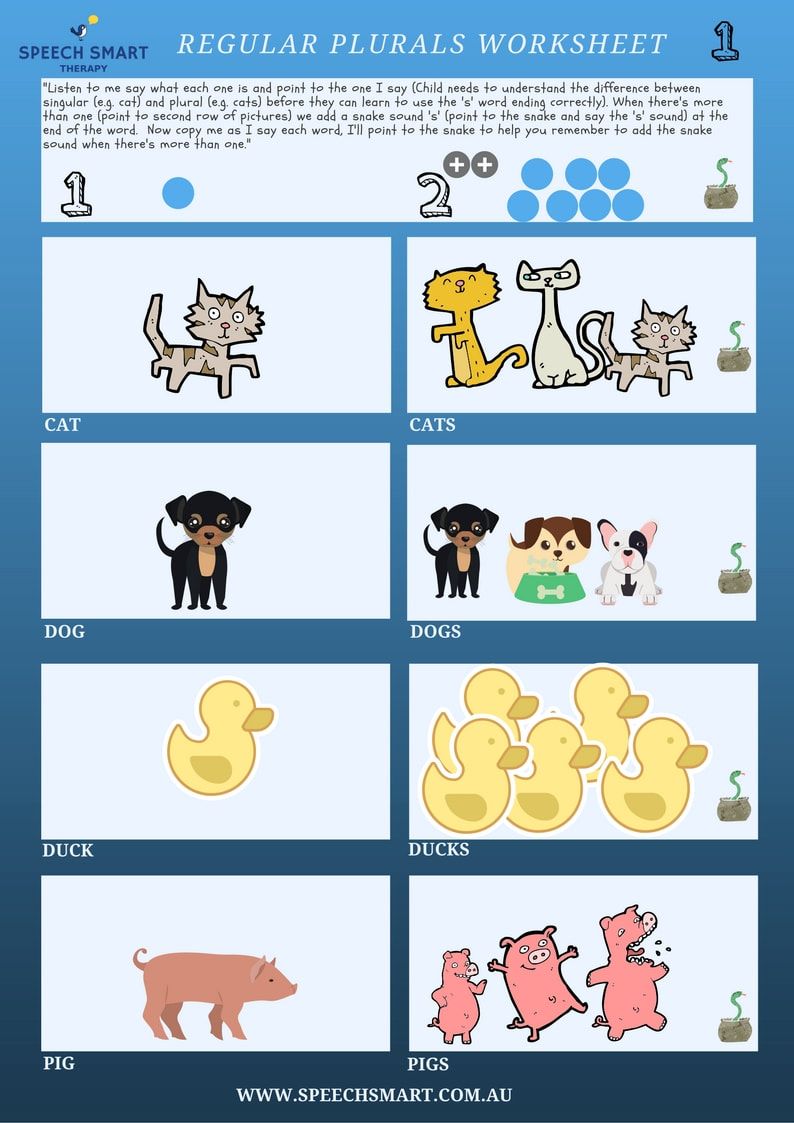 Here are some regular plurals worksheets you can use to teach understanding and use of regular plurals. Children with speech and language delays often have trouble adding the 's' or 'z' sounds at the ends of words to indicate 'more than one' or 'many'. Many children develop this knowledge and skill by 3 years of age. However, some children may require additional support to understand and use these word ending. Parents, teachers and speech pathologists may find this a useful resource to use to support children needing a little extra support with regular plurals. Here are some easy steps for teaching regular plurals: Step 1: Check Understanding: The first step is to check the child can understand the difference between singular (e.g. cat) verses plural noun (e.g. cats) use by identifying the correct pictures when you say them. If they have trouble doing this it will be important to do further work on their understanding of singular verses plural noun understanding, before you work on their production/use. Use the visual supports at the top of each worksheet when asking the child to point to the one you say. For example, point to the number 1 and then the single blue dot when you say, "Find one cat.", point to the 7 blue dots and then the snake symbol when you say, "Find many cats" or "Find three cats". Make sure you point to the snake symbol at the same time as you say the 's' sound or the buzzy bee symbol at the same time as you say the 'z' sound at the end of the target words. This will help support the child's awareness of the use of this sound to indicate 'more than one'. Get the child to use a white board marker to tick the picture, once they've found the right picture - most kids love doing this! To make this task a little bit trickier try without the visual support at the top of the page and remove the quantity word clues (i.e. 1, 2, many) from your instructions but continue to point to the snake sound or the buzzy bee sound as you say the sound at the end of the plural noun. For example, "find a cat", next "find the cats". Step 2: Correct use of singular v's plurals: Once your child can easily point to the correct picture when named move onto their production by getting them to copy you. For example, you may say to your child, "When there's more than 1 (point to the 7 dots at the top of the second row) we add a snake sound 'sss' (point to the snake at the same time that you say the 's' sound) at the end of the word. Now copy me as I say each word, I'll point to the snake to help you remember to add the snake sound when there's more than one." Once your child's getting really good, see if they can tell about each picture using the correct word ending 's' or 'z' to tell when there's more than one, all on their own. It may help to get them to point to the 'snake sound symbol' and 'buzzing bee sound' symbol to remind them when they need to use these sounds at the end of the word. If your child seems to be helped by the use of quantity words (e.g. 1, 2, 3, many), use the plural noun in a carrier phrase like "I see ...". Your child could say, "I see one cat." "I see three cats." Keep doing this until your child can consistently use plural nouns in simple sentences to tell when there is more than one of something. Step 3: Generalisation of Plural Use: Now that your child is starting to use plurals correctly we want to make sure this skill transfers to everyday situation. This means talking about 'one' verses 'many' in everyday situations. You're child could help you sort the washing out e.g. You could instruct your child "Put one jumper here. Put three jumpers here. Then ask them to tell you what's in each pile to encourage them to say "here is one jumper, here are three jumpers." Reading books and talking about what's in the pictures is another great way to encourage this skill to transfer to everyday situations. Ask your child questions like, "what do you see here?" to see if they include the plural 's' or 'z' endings. Give heaps of praise when they remember to use the ending correctly and gently remind them if they forget by either scaffolding the right way to say the sentence, "oh, there's three cats", and/or reminding them to use the snake sound at the end, "three cats", we need to put the snake sound at the end of "catsss", can you tell me again. Let me know if you like this resource. Thanks heaps!
|
Author - Sarah CreaghI'm a speech pathologist with a passion for working in partnership with parents to support children to reach their maximum potential. Archives
September 2018
Categories
All
|
||||||||||||||||||


 RSS Feed
RSS Feed

